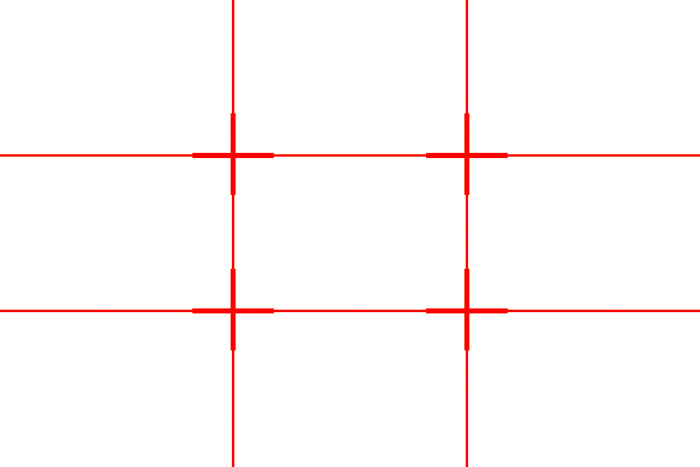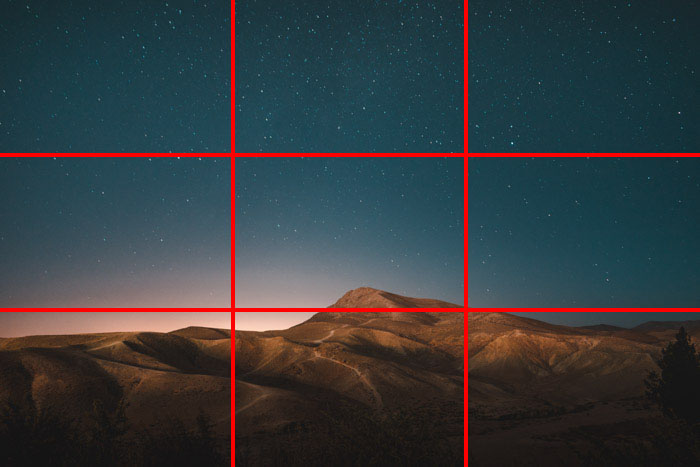What Is the Rule of Thirds in Photography Composition?
The composition is how you arrange the subject and objects within your frame.
The rule of thirds is dividing your frame into nine equal rectangles. You can do this by creating two vertical and two horizontal lines. The four lines will intersect at four points. These are the points where your point of interests should be. You can do this mentally

How to Use Points of Interest
The relationship between negative space and the subject creates a natural focal point. By default, the viewer looks at the intersection points. Placing points of interest at one of these points balance your image. This also creates more tension, energy, and interest in the photograph.
In a portrait, the subject or other main points like the subject’s eyes, are important. Place these elements on one of the intersections.
For instance, the subject in the photo below is on one of the intersections. The same goes for landscape photography, like in the image below. Using the rule of thirds, the photographer placed key elements on the intersections.
Important Compositional Elements
Some images like landscapes, seascapes, and cityscapes don’t have one point of interest. Aim to divide the image into one-third and two-thirds. For example, when capturing a landscape, use the rule of thirds to place the horizon on a horizontal line.
This photo below is more interesting. The landscape takes up 1/3 of the image, where the sky takes the remaining 2/3.
This is an effective way to show two elements, where one is more important than the other. This image would not be as dynamic if the sky were only 1/3.
Can You Break the Rule of Thirds?
Of course, you can break the rule of thirds. But before breaking the rule, it is important to learn it. In general, only break the rule for a specific reason.
Example: The subject doesn’t fall on any of the intersections. Nor are any of the key elements (things you want to make the viewer pay attention to) on the grid lines. The story behind the image was strong enough to justify breaking the rule.
Try these things while you're collecting your soil samples or doing activities in School next week with these challenges:
landscape- the area where you found the soil- try all around it and a landscape can also be a vertical or "portrait" oriented image. This can help with note taking- a visual record of the environment around you. Maybe there is some interesting archetecture, an unusual buisness that might effect the lanscape, maybe it's near water or perhaps there are flowers you like or litter you want to document to raise awareness.
action - get some action shots of you collecting the samples, have a family member help or do some selfies. Documentary photography usually refers to a popular form of photography used to chronicle events or environments both significant and relevant to history and historical events as well as everyday life or science communication.
texture and abstract - get up close to the soil or interesting items you see around- experiment with angles and perspectives. Abstract photography, sometimes called non-objective, experimental or conceptual photography, is a means of depicting a visual image that does not have an immediate association with the object world and that has been created through the use of photographic equipment, processes or materials.
'Studio' Style
try taking some items home and putting them on a black background - I use my black hoodie as a background. Try using directional lighting with a torch or window light, or the flash of your camera just to see how it changes the way the object looks.
I do the same thing with selfies or portraits - using a black background and lighting I can make some professional looking images.
I sometimes use Snapseed to edit my images later- it's a free phone image capture or editing app that's fun to play around with! If you have other things you want to do- like draw a picture or pictures from your outings or create some effects that would be great to see the inspiration and what you make with it.
Composition is as important as lighting - but when in doubt I just take a lot of pictures from a lot of different angles and perspectives and have my friends help me pick the good ones later.
When you've made some photographs you like connected to the Soil activities (collecting and in school activity) post them to your blog along with any thoughts you had about it.
No comments:
Post a Comment